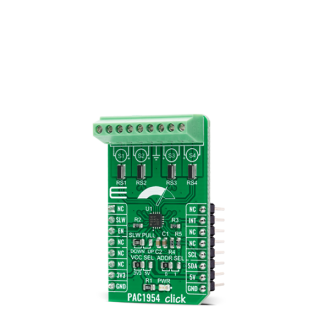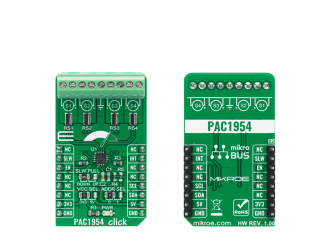
We strongly encourage users to use Package manager for sharing their code on Libstock website, because it boosts your efficiency and leaves the end user with no room for error. [more info]

Rating:
Author: MIKROE
Last Updated: 2021-06-04
Package Version: 1.0.0.0
mikroSDK Library: 1.0.0.0
Category: Measurements
Downloaded: 2542 times
Not followed.
License: MIT license
PAC1954 Click is a compact add-on board that contains an energy monitoring solution. This board features the PAC1954, a four-channel DC power/energy monitor from Microchip Technology.
Do you want to subscribe in order to receive notifications regarding "PAC1954 click" changes.
Do you want to unsubscribe in order to stop receiving notifications regarding "PAC1954 click" changes.
Do you want to report abuse regarding "PAC1954 click".


Library Description
The library covers all the necessary functions to control the PAC1954 click board.
Key functions:
void pac1954_single_write( uint8_t reg_addr, uint8_t data_in ) - This function writes a single data byte to the selected register.void pac1954_refresh_cmd( void ) - float pac1954_get_calc_measurement( uint8_t meas_sel, uint8_t ch_sel, uint8_t avg_sel, uint8_t meas_mode ) - Examples description
The application is composed of three sections :
void application_task ( )
{
pac1954_refresh_cmd( );
vsource = pac1954_get_calc_measurement( PAC1954_MEAS_SEL_V_SOURCE,
PAC1954_CH_SEL_CH_1,
PAC1954_AVG_SEL_ENABLE,
PAC1954_MEAS_MODE_BIPOLAR_FSR );
isense = pac1954_get_calc_measurement( PAC1954_MEAS_SEL_I_SENSE,
PAC1954_CH_SEL_CH_1,
PAC1954_AVG_SEL_ENABLE,
PAC1954_MEAS_MODE_BIPOLAR_FSR );
power = pac1954_get_calc_measurement( PAC1954_MEAS_SEL_P_SENSE,
PAC1954_CH_SEL_CH_1,
PAC1954_NULL,
PAC1954_MEAS_MODE_BIPOLAR_FSR );
FloatToStr( vsource, log_txt );
Ltrim( log_txt );
float_cut( );
mikrobus_logWrite( "V(source) is ", _LOG_TEXT );
mikrobus_logWrite( log_txt, _LOG_TEXT );
mikrobus_logWrite( " V", _LOG_LINE );
FloatToStr( isense, log_txt );
Ltrim( log_txt );
float_cut( );
mikrobus_logWrite( "I(sense) is ", _LOG_TEXT );
mikrobus_logWrite( log_txt, _LOG_TEXT );
mikrobus_logWrite( " A", _LOG_LINE );
FloatToStr( power, log_txt );
Ltrim( log_txt );
float_cut( );
mikrobus_logWrite( "P(sense) is ", _LOG_TEXT );
mikrobus_logWrite( log_txt, _LOG_TEXT );
mikrobus_logWrite( " W", _LOG_LINE );
mikrobus_logWrite( "", _LOG_LINE );
Delay_ms( 1000 );
}
Other mikroE Libraries used in the example:
Additional notes and informations
Depending on the development board you are using, you may need USB UART click, USB UART 2 click or RS232 click to connect to your PC, for development systems with no UART to USB interface available on the board. The terminal available in all MikroElektronika compilers, or any other terminal application of your choice, can be used to read the message.